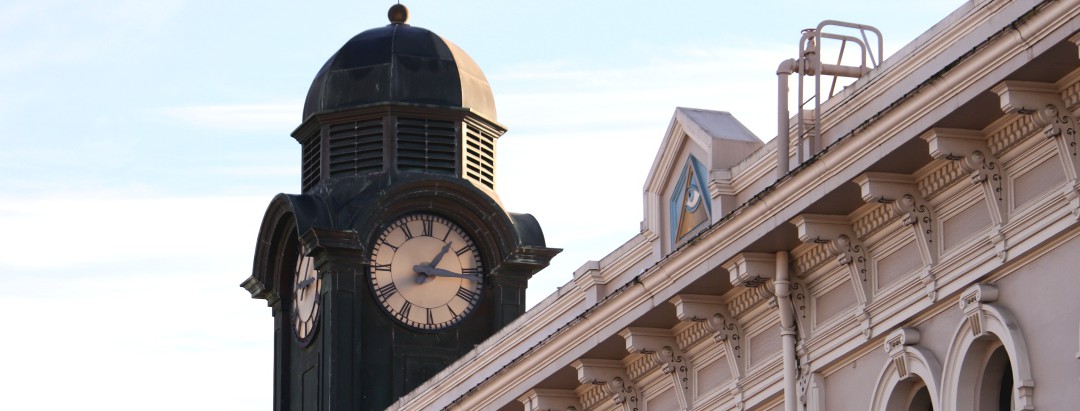Published August 18th, 2016 in the Argus-Courier by Eric Gneckow
Wielding the nozzle of a specially designed vacuum while standing atop a 40-foot-tall lift, Chris Conrad maneuvered close to an alcove under the Masonic hall clock tower off Petaluma’s Western Avenue.
He was not alone in his high-altitude perch, having drawn the attention of the tens of thousands of bees that had made the spot home over the past few months. With a flip of a switch, Conrad began to suck up globs of the insects, quickly revealing glimpses of the complex folds of waxy comb built under the building’s eaves.
Now standing in the middle of an aggravated, roaring hum of stinger-equipped insects, Conrad wasn’t phased, carefully easing huge sections of comb out from the space.
“If they stayed here for the winter, they would have died,” he said.
135 years after the Freemasons erected their stately lodge in Petaluma, builders of another kind — European honeybees — have spent the summer constructing a home of their own amid the hall’s elaborate parapets.
While most bees choose a more discreet location, Conrad said, the approximately 50,000-strong colony at Western and Petaluma Boulevard had made the unusual decision to build its hive on a highly exposed edifice at one of the city’s most recognizable intersections.
It was a rare opportunity to see first-hand how Conrad, part of a buzzing collective of professionals and enthusiasts known as the Sonoma County Beekeepers’ Association, captures and relocates the pugnacious pollinators.
“Every bee gets treated like it’s the queen,” he said, gently loading sections of comb containing dozens of tiny larvae into a special rack to be transported elsewhere.
Seeming at first to be a temporary intrigue, the swarm’s decision to set up permanent residence on the building became a source of growing concern for members of the Freemason Petaluma-Hamilton Lodge, said Randy Stewart, building manager. Windows that once welcomed in the cool breeze would stay closed during events like a monthly family dinner, as the specter of a sting, particularly for those with bee allergies, loomed large.
Despite the nuisance, Stewart said the organization did not consider eradication with insecticide or other means an option.
“It’s just more humane, and more bee-conscious to take care of them properly and have them relocated so that they can survive,” he said.
Stewart originally contacted Ettamarie Peterson, an icon of the Petaluma-area beekeeping community, to attempt to relocate the hive. Often cited as the “Petaluma Bee Queen,” Peterson said she had taken note of the bees as early as May.
The group at first appeared to be a swarm that had budded off from another established colony, which occurs when the population grows too large, she explained. The swarm takes the existing queen with it, and bounces around until it finds a permanent place to call home.
Peterson listed several known areas in the historic downtown where bees have set up established colonies, and theorized that the colony at the mason’s hall was the offshoot of a hive at the Independent Order of Odd Fellows building on Petaluma Boulevard.
“They just kind of moved there from one fraternal organization to the other,” she said with a laugh.
Peterson placed a specially designed box – a“bait hive”– on a fire escape near the swarm with the hope of enticing it to relocate, but soon realized that the colony seemed content on the relatively exposed building face.
“They’re really not very bright bees – they don’t have very good real estate agents, I guess,” she said, describing how swarms will typically send out scouts to find a suitable location. “They’re usually hidden under a canopy of leaves. These, I guess they felt sheltered because of the overhang of the roof, and the two decorative features they tucked in-between.”
Faced with a 20-foot gap to reach the hive, Peterson suggested the masons call Conrad.
With nine years in business as Bee Conscious Bee Removal, Conrad explained that bee populations across the country are in decline. The U.S. Department of Agriculture’s Agricultural Research Service cites a likely combination of “parasites and pests, pathogens, poor nutrition and sub-lethal exposure to pesticides” for the trend, noting that the stakes are high since “about one mouthful in three in our diet directly or indirectly benefits from honey bee pollination.”
At least in Sonoma County, the trend has given rise to a heightened desire to foster the proliferation and health of local bee populations, Conrad said. Yet removing and relocating live bees with their hive intact has practical implications, too.
In the case of the masonic hall’s new tenants, spraying the hive with water could send globs of angry bees falling to the sidewalk, an outcome Conrad explained was likely to come with some concerning implications for pedestrians. And in typical scenarios of hives established in closed areas like walls and attics, killing bees with pesticide would stop them from drying out the still-moist honey within.
“The bees take nectar out of a flower that is 50 percent water. They dehydrate it using their wings and the temperature of the hive,” he said. “If you plugged it up or killed the bees, all of that nectar would ferment and become the original alcoholic drink called mead, which is what the Vikings got loaded on” he said.
The fermented honey would then attract ants, and other bees attracted to the smell could end up consuming the insecticide and dying themselves, he explained.
The hive at Western and Petaluma Boulevard didn’t contain much honey, since the bees were spending most of their energy keeping warm in the highly exposed area, Conrad said. In a more sheltered location, they’d have a better shot at survival, he said.
That location turns out to be Peterson’s Farm off Gossage Avenue, where Ettamarie Peterson will be taking in the colony to join the others located at the property.
“Every colony we can save is one more colony in the world of bees,” she said. “Bees are important to pollination, and we need the bees.”


